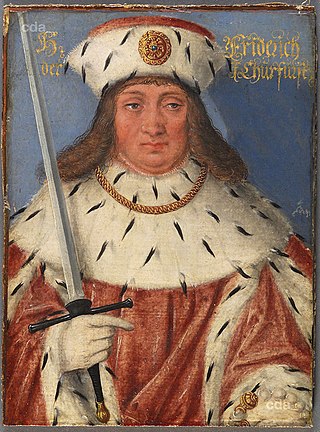Related Research Articles
The Duke of Silesia was the title of sons and descendants of the Polish Duke Bolesław III Wrymouth. In accordance with the last will and testament of Bolesław, upon his death his lands were divided into four or five hereditary provinces distributed among his sons, and a royal province of Kraków reserved for the eldest, who was to be High Duke of all Poland. This was known as the fragmentation of Poland. Subsequent developments lead to further splintering of the duchies.

The Duchy of Silesia with its capital at Wrocław was a medieval duchy located in the historic Silesian region of Poland. Soon after it was formed under the Piast dynasty in 1138, it fragmented into various Silesian duchies. In 1327, the remaining Duchy of Wrocław as well as most other duchies ruled by the Silesian Piasts passed to the Kingdom of Bohemia as Duchies of Silesia. The acquisition was completed when King Casimir III the Great of Poland renounced his rights to Silesia in the 1335 Treaty of Trentschin.

Frederick I, the Belligerent or the Warlike, a member of the House of Wettin, ruled as Margrave of Meissen from 1407 and Elector of Saxony from 1423 until his death.

Leśna is a town in Lubań County, Lower Silesian Voivodeship, in south-western Poland, close to the Czech border. It is the seat of the administrative district (gmina) called Gmina Leśna. As of 2019, the town has a population of 4,439.
Conrad I, called the Great, a member of the House of Wettin, was Margrave of Meissen from 1123 and Margrave of Lusatia from 1136 until his retirement in 1156. Initially a Saxon count, he became the ruler over large Imperial estates in the Eastern March and progenitor of the Saxon electors and kings.

The Duchy of Münsterberg or Duchy of Ziębice was one of the Duchies of Silesia, with a capital in Münsterberg (Ziębice). Existing from 1321/1322 to 1742, it was located in what came to be referred to as Lower Silesia. Its territory is similar to modern Ząbkowice Śląskie County in Poland.
Jan I of Żagań was a duke of Żagań-Głogów from 1397, from 1403 Duke of Żagań, Krosno Odrzańskie and Świebodzin and from 1412 sole ruler of Żagań and Przewóz.
Henryk IX Starszy was Duke of Żagań-Głogów from 1397 to 1412, ruler of Szprotawa, Krosno Odrzańskie from 1412 to 1417, Świebodzin and half of Głogów, from 1417 ruler of Szprotawa, half of Głogów, from 1420 ruler of Kożuchów and Zielona Góra, from 1430 ruler of Krosno Odrzańskie and Świebodzin, and from 1446 Duke of Lubin.

Konrad IV the Elder was Duke of Oels (Oleśnica), Koźle, half of Bytom and half of Ścinawa from 1412 to 1416, sharing rule with his brothers. After 1416, he became the sole ruler of Kąty, Bierutów, Prudnik and Syców. In 1417, he assumed the role of Bishop of Wrocław and also held the title of Duke of Nysa.

Konrad V Kantner was a duke of Oleśnica, Koźle, half of Bytom and half of Ścinawa during 1412–1427, since 1427 sole ruler over Oleśnica.
Euphemia of Münsterberg, also known as Euphemia, Countess of Oettingen, was a princess from the Münsterberg (Ziębice) branch of the Piast dynasty, by marriage Countess of Öttingen and sovereign Duchess of Münsterberg during 1435–1443.

Duchy of Jawor was one of the Duchies of Silesia and medieval Poland established in 1274 as a subdivision of the Duchy of Legnica. It was ruled by the Silesian Piasts, with its capital at Jawor in Lower Silesia.

Kłodzko Land is a historical region in southwestern Poland.

The Bohemian Poděbrady family was a noble family in Bohemia, arising from the Lords of Kunštát. After Boček of Kunštát had acquired the Lordship of Poděbrady by marriage, he called himself "Boček of Kunštát and Poděbrady". The most prominent member of the family was George of Poděbrady, who was king of Bohemia. His sons were raised to imperial counts and Counts of Glatz. They founded the Silesian branch of the family, the Dukes of Münsterberg.

Hynek Krušina of Lichtenburg was a Hussite commander and governor and lien holders of the County of Kladsko, the Duchy of Münsterberg and the city of Ząbkowice Śląskie.

Přemek I, Duke of Opava' was a member of the Opava branch of the Bohemian Přemyslid dynasty. He was Duke of Opava from 1367 until his death and Głubczyce from 1394 until his death.

Duke William of Opava was a member of Opava branch of the Bohemian Přemyslid dynasty. He was Duke of Opava from 1433 to 1452 and Duke of Münsterberg from 1443 to 1452.

Duke Wenceslaus II of Opava was a member of the Opavian branch of the Přemyslid dynasty. He was Duke of Opava from 1433 until his death. From 1435 until his death, he was also Duke of Głubczyce and Lord of Fulnek.
Půta III of Častolovice was a member of the Bohemian Častolowitz family. He was Landeshauptmann and later pledge lord of the County of Kladsko and the Duchies of Ząbkowice Śląskie and Münsterberg.
Půta I of Častolovice was an east Bohemian nobleman. He was a member of the noble Častolovice family and held high office in Bohemia.
References
- Ludwig Petry et al.: Geschichte Schlesiens, vol. 1, Sigmaringen 1988, ISBN 3-7995-6341-5, p. 197–198, 208